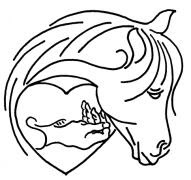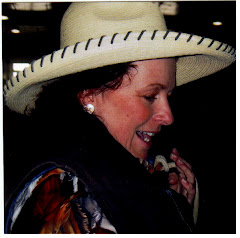
Because I am a retired school teacher I find it helpful to divided learning into smaller chucks so that it is easier for the student to digest. I believe that there are (four main categories or roads) we need to take in order to become better horsemen. I have also discovered that progress is much quicker and improvement enduring if we take these roads in a specific, sequential order. Therefore we avoid getting lost on the journey.
When we become proficient in one category then our experience on the next road will be much easier. In other words the road to becoming a better horseman will be a lot smoother when we build our skills with purposeful progression. It is when we try to take short cuts that the road becomes very bumpy and more difficult. While it may be possible to jump onto any road (or category) at any time, and sometimes it may even be necessary depending upon the situation, it does help to go in an order. Traveling in this manner is a lot more pleasant for both the horse and rider plus the results are far superior to anything I have every tried in the past.
We need to develop skills in these four categories on our road to becoming better horsemen: 1) Develop a Learning Frame of Mind for both horse and rider.2) Advance Groundwork 3) Improve Rider’s Posture4) School the horse for Optimal Movement and Self-Carriage
Within each of these four categories there are different levels; beginning with the easiest and most fundamental skills and building up to the most complicated aspects of training. It doesn’t matter where you are right now, or if you ever want to achieve the most complicated and advanced maneuvers with your horse. What matters most is that you have a general understanding and skill set in each of these categories so that you can be safe and have more fun with your horse.
Here are some of the things I have realized about each category on my own road to becoming a better horseman.
1) Developing a Learning Frame of Mind
What is involved?
- It is so important for the rider to have an awareness of self.
- It is imperative the rider be very attentive to the horse.
- It is valuable to know how to get and keep a horse’s attention.
- It is foremost that the rider has great intention and focus.
- It is essential for the rider to be a calm leader in a variety of situations.
- It is significant that the person be able to read a horse and understand behaviors.
- It is vital the person breaks through any defensive behaviors in the horse.
- The central key is developing a relationship with the horse which means a healthy happy partnership. It doesn’t matter whether it is a young or old horse, a problem or challenging horse, a remedial or rescue horse, because all horses will appreciate this and therefore become more willing.
- It is crucial that the person have an open mind to new learning.
- It is necessary the person is willing to experiment and learn from mistakes.
- The attitude the rider has towards the horse will have a great influence on everything you do with him.
2) Advance Groundwork
What is the focus?
- Developing the balance, feel and timing of the rider is just as important in ground work as what we are doing with the horse. Everything we do on the ground is transferrable to riding for both the horse and rider.
- Balance and communication are best developed in the context of groundwork because the separation helps clarify “issues” that are most often the result of miscommunication or misunderstandings between horse and rider.
- How equipment affects communication and motion is best assessed in this category. A rider can become fully aware of various training equipment, ropes, halters, whips, sticks, saddles, padding and bridles and how to use them better because they do not have the added things to think about while being on the horse’s back.
- The difference between aids and contacts is clarified and both the horse and rider learn their specific roles in the partnership.
- Undesirable behavior issues can be dealt with in a safe way. The change of behavior on the ground can and will transfer to riding. Get it better on the ground and it will be better when riding.
- Habits are created, which will affect either positively or negatively the daily handling with your horse, from vet care to trailer loading.
- Three layers of advancement in the horse and rider:
Emotional balance (calm and attentive during exercises),
Mental balance (understanding exercises and skill development)
Physical balance (energy, relaxation and self-carriage within the exercises).
3) Improve Rider’s Posture
How do we do it?
- Focus on the rider’s balance and position through awareness exercises performed in a specific order.
- Separate the rider’s balance from the horse’s balance so that the rider can become more aware of exactly where and how the horse is struggling and then offer better assistance.
- As the rider¹s balance improves, feel improves and then the timing of the aidsprovides clear communication that is recognizably useful to the horse.
- Ideally this begins on the ground using exercise balls and reins for simulation exercises.
- A safe lesson horse is an invaluable tool where the rider is on a longe line without reins.
- Once in the saddle, this category of training focuses on the rider finding their own point of balance and working from their core on the back of a horse.
- A video tape or a set of professional eyes on you with constructive criticism are priceless learning tools about your posture. This can be a painful process but you will learn more about your posture from these experiences than any other.
- Correct posture also helps a rider feel safer. A feeling of security allowsthe rider to be more confident with calm leadership from the saddle which the horse is looking for.
- Having a sense of balance that is independent of the horse’s motion is what professional riders have that gives them the ability to ride a variety ofhorses very well. While this level of quality is not often taught to non-professional riders I believe it is imperative for all riders to learn because the correct development of a horse depends on good rider posture.
4) School the horse for Optimal Movement and Self Carriage
Why is it necessary?
- Focus on helping the horse achieve balance while carrying a rider.
- Finding correct use of the body while bearing the weight of a rider is a learned skill for a horse and one that is often ignored.
- Although a horse can and often do what is asked while out of balance the cumulative effect of riding an unbalanced horse can be lameness, illness or behavioral problems.
- Understanding the difference between the most advantageous motion and acceptable motion helps the rider understand WHY the horse is behaving poorly, performing poorly or having chronic health issues.
- It is a simple matter of (basic physics) between the rider’s body, the horse’s body and gravity. When these dynamics work together then harmony is achieved.
- By helping the horse achieve his best possible movement with self-carriage under saddle we show the horse that his need for safety and comfort in the exercises we ask him to do are as important as our own agenda of pleasure or performance.
- The fundamental skill of helping a horse find his finest movement with self-carriage which is not forced but is relaxed with balance and energy is crucial for the health and well being of a horse whether he is only ridden on the trails once a week or is expected to go to Grand Prix.
As we travel down the road to becoming better horsemen these four categories will help give us a proper road map which will lead us to our desired destination. The better our learning frame of mind is the better our ground work will be, the better our ground work is the better the horse will ride, the better the rider’s posture is the horse will be able to move with more freedom and proper self-carriage, which is the kind of ride that dreams are made of whether you are a recreational trail rider or competitor at any level.
Happy Trails,
Sherry Jarvis
Author of Win Your Horse's Heart (And Be a Better Horseman)
“Good better best, never let it rest, make your good better and your better best” – George Burns
"It's been a long, long road but it's paying off, baby."--Calvin Borel
"High achievement always takes place in the framework of high expectation"--Charles Kettering













